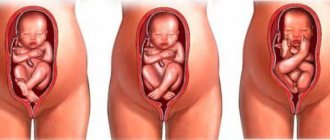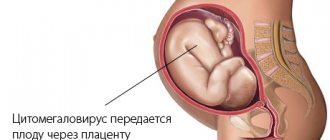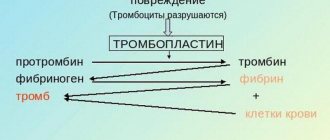Ultrasound is one of the safest methods in modern medicine. This diagnostic procedure is used to study the structures of dense organs, such as the liver, prostate gland, heart, cerebral vessels, uterus, ovaries, mammary glands, joints. This method is not used to examine organs filled with air, for example, intestines, lungs. Since the use of this diagnostic procedure is harmless, ultrasound is widely used to examine internal organs in children and pregnant women.
- Operating principle of ultrasound
- Indications for ultrasound
- Preparing for an ultrasound
- How is the procedure performed?
- Contraindications to ultrasound
- Ultrasound price
- Where can I sign up for an ultrasound scan in Moscow?
What is the name of the doctor who does ultrasound: who is he and what does he do?
At first glance, it may seem that doctors who perform ultrasound examinations occupy the same position, but this is not the case. It all depends on the size of the medical facility and the specifications.
Officially, the position of the doctor responsible for examination using the ultrasound method is “doctor of functional diagnostics” or “doctor of ultrasound diagnostics”. Depending on the specification of the medical specialist, an anatomical area may be added to the vacancy title, the study of which is performed by a specific ultrasound specialist. This list includes:
- abdominal organs;
- pelvic organs;
- heart area;
- vessels of the head or neck;
- thyroid gland and the like.
This statement is true only in Russia, since in Western countries the situation is slightly different. In European countries and the USA, ultrasound doctors ceased to exist several decades ago - each specialist has his own device and has the skills to use it. For this reason, there is no need for separate sonologists to conduct this examination.
Ultrasound of the pelvic organs in women: how to prepare for it and how the study is carried out
The female body is an extremely fragile mechanism that requires attention and care. But how can you determine what changes are occurring in your body, check whether everything is normal or is it time to pay attention to the condition of this or that organ? Ultrasound diagnostic specialists help women answer these questions.
The most frequently visited type of such examination by women, for well-known reasons, is ultrasound of the pelvic organs. But many, due to ignorance and prejudice, are afraid of the procedure. In our article we will tell you in detail and truthfully how a pelvic ultrasound is performed, how to prepare for it and what results can be obtained. We hope this helps you overcome your fear of research.
What is the competence of an ultrasound doctor?
In Russian conditions, the competence of an ultrasound physician is a rather vague concept, and in response to a request to describe it, it is not always possible to give a clear and understandable answer. The job description states that an ultrasound diagnostic doctor is engaged in diagnostic studies and issues conclusions about the study performed.
Depending on the specifications of the medical institution and the equipment used, the list of diagnostic forms may vary. In large vascular centers and specialized departments, complex studies using contrast agents can be performed, but they usually also carry out banal examinations, for example, ultrasound of the thyroid gland or Doppler ultrasound of the vessels of the head.
What groups of ailments does he diagnose?
According to current standards and rules, an ultrasound diagnostician is an “auxiliary” specialist who is involved in describing the pathology, but not making a diagnosis. Ultrasound is an imaging technique that helps evaluate the condition of internal organs, including:
- size;
- shape;
- consistency;
- the presence of stones and much more.
In some cases, an ultrasound is performed by a vascular surgeon or an obstetrician-gynecologist. So, if the latter performs an ultrasound during pregnancy, he has the right to make a diagnosis. If we are talking about vascular pathologies, then it is possible to clarify the presence of blood clots, stenosis and other anatomical changes.
Which organ diseases does an ultrasound doctor diagnose?
Thanks to the improvement of modern ultrasound machines, using ultrasonic waves, it is possible to examine all parenchymal organs: the liver and spleen during abdominal ultrasound, the uterus or prostate during scanning of the pelvic organs, the thyroid gland, blood vessels, and so on.
In some cases, nearby organs may create interference that makes it difficult to see the organ clearly. In this case, contrast studies related to additional methods are performed in large diagnostic and treatment institutions.
In general, the answer to the question “What is an ultrasound (ultrasound diagnostic) doctor?” simple - this is a multidisciplinary specialist who helps in establishing and clarifying the diagnosis. Without his help, competent pathogenetic therapy is impossible.
The significance and features of the use of 3D/4D ultrasound for fetal examination
Ultrasound scanner HS50
Affordable efficiency.
A versatile ultrasound scanner with compact design and innovative capabilities.
3D/4D ultrasound examination (US) is well known at the present stage. There is no doubt that this method opens up new research opportunities in obstetrics and gynecology, especially when examining the fetus [1, 2]. However, there is still debate about the appropriateness of volumetric ultrasound. Usually the thesis is put forward that 2D echography is sufficient to achieve the goal in diagnosis, and 3D only “decorates” the detected pathological condition or simply beautifully demonstrates the image of organs or objects. One cannot but agree that two-dimensional ultrasound is the basis of modern echography and, thanks to it, doctors have achieved great success in solving many clinical problems in obstetrics, diagnosing diseases and malformations in the fetus [1, 3]. At the same time, it would be naive to believe that all diagnostic problems have been solved and new techniques should not be developed in practice, introducing them to solve routine problems or to improve the accuracy of detection and detailing of anomalies.
The basic principles of operation of devices and sensors for 3D/4D ultrasound are outlined in many monographs and manuals [1, 4]. However, I would like to highlight a number of important improvements that have appeared in volumetric ultrasound in recent years. The possibility of obtaining three-dimensional images using ultrasound has been known for several decades. For clinical use, the volumetric method has become attractive with the advent of real-time three-dimensional ultrasound (4D). This mode made it possible not only to quickly obtain an image for subsequent visual assessment, but also to improve its actual quality due to the ability to quickly correct the scanning angle in order to reduce artifacts and increase image reliability. The basic operating modes of most modern 3D instruments can be represented in terms of five basic functions: surface mode, multiplane, multiplane, volumetric negative and real-time multiplane (STIC).
This work is a study of some of the possibilities of 3D/4D ultrasound within the framework of echographic examinations in obstetrics for various purposes in the I-III trimester of pregnancy.
The material was the experience of using 3D/4D ultrasound for 7554 examinations during pregnancy 6-41 weeks. Various developmental anomalies were observed in 209 fetuses. The studies were carried out on ultrasound scanners from MEDISON (Korea), equipped with 3D/4D ultrasound functions and software packages for dynamic and static analysis of three-dimensional images. The total time for fetal examinations was timed and varied from 6 to 30 minutes, on average it was about 19 minutes (without analysis in the processing mode of already obtained images). In all cases, a standard 2D obstetric examination was also carried out, the time spent on it is included in the total examination time. There was a tendency to increase the duration of the entire study after 29-32 weeks of gestation.
Surface mode
3D/4D ultrasound made it possible to visualize the surfaces of the fetal body (forehead, face, anterior chest, genital area, back of the head and back, distal limbs, joints of the limbs) at a gestation period of 11-22 weeks in most cases (93%) ( Fig. 1-4). Difficulties in visualizing individual surfaces were noted in 24% due to the peculiarities of the fetal position, the location of the limbs and other parts of the body, the location of the umbilical cord, and the amount of amniotic fluid. Fetal motor activity and polyhydramnios greatly facilitated the task of surface visualization. It should also be taken into account that the complete absence of amniotic fluid in all cases did not allow us to obtain information about the surfaces of the fetus in this mode. Difficulties in obtaining surface images were noted in 38% of cases during examinations of fetuses after 35 weeks of gestation.
Rice. 1.
Pregnancy 12 weeks (superficial mode). The face of a healthy fetus.
Rice. 2.
Pregnancy 11-12 weeks (superficial mode). Alobar holoprosencephaly. Hypotelorism. Cebocephaly, proboscis.
Rice. 3.
Pregnancy 12 weeks (superficial mode). Median cleft lip and palate.
Rice. 4.
Pregnancy 10-11 weeks (superficial mode). Omphalocele.
Multiplane mode
3D/4D ultrasound, the historical basis of volumetric ultrasound, was used in all cases. In this case, the image of various parts of the fetal body was simultaneously visualized in three perpendicular planes (Fig. 5-7). Dynamic 4D mode was used to visualize the fetal spine in all examinations, as well as to find an acoustic window for use in other modes. In some cases, the need for static use of this mode was due to difficulties in obtaining individual planes in 2D ultrasound. This is especially true for sagittal and frontal scans of the fetal brain. We used the same scanning mode to measure the volume of cystic formations in the fetus using VOCAL technology. Low water was an obstacle to using all the capabilities of this regime.
Rice. 5.
Pregnancy 11-12 weeks (surface 3D/4D mode). Spina bifida in the cervical, thoracic and lumbar regions.
Rice. 6.
Pregnancy 19-20 weeks (multiplane regimen option). Dysplasia of the thoracic and lumbar vertebrae.
Rice. 7.
Pregnancy 20 weeks (multiplane mode). Meningomyelocele in the lumbosacral spine.
Multiplane mode
3D/4D ultrasound combined with 3D XI and Multi-Slice software has been used in most studies to obtain clear two-dimensional images of selected internal fetal organs. At the same time, the success of obtaining only one scan of a specific area without artifacts made it possible to obtain almost any other planes without additional contact scanning (Fig. 8, 9). This circumstance significantly reduced the ultrasound exposure time. In this mode, the necessary measurements of small objects or distances (nasal bone, thickness of the collar space, etc.) were made for better accuracy. In all cases of suspicion or detection of anomalies in the fetus, the mode made it possible to significantly improve the understanding of the altered organ, the details of the defect, and to carry out full documentation, saving the results in the form of a file. Such a file can subsequently be examined virtually echographically again, if necessary, many times, even by other specialists. The use of such technology in ultrasound turns echography into an objective diagnostic method, which is not inferior in objectivity to magnetic resonance or computed tomography (Fig. 10, 11).
Rice. 8.
Pregnancy 10-11 weeks (multi-plane mode, step 0.3 mm). Research in ecological style. Transvaginal scan. Collar space.
Rice. 9.
Pregnancy 20-21 weeks (multi-plane mode, step 0.4 mm). Sagittal and parasagittal scanning of one of the cerebral hemispheres. Agenesis of the corpus callosum. Communicating external-internal hydrocephalus. Lisencephaly (agyria).
Rice. 10.
Pregnancy 19-20 weeks (multi-plane mode option). Virtual scanning of a 3D/4D file with an image of the fetal brain. The process of obtaining the parasagittal plane of one hemisphere from the frontal plane. The result was 2D images of the surface of the insula and the periventricular region of one of the hemispheres.
Rice. eleven.
Pregnancy 7-8 weeks (multi-plane mode option). Transvaginal examination. Virtual scanning of a 3D/4D file in an ecological style. The process of obtaining a longitudinal 2D scan of an embryo from a transverse plane. As a result, the anterior, middle and posterior brain vesicles are visualized.
Negative volume mode
3D/4D ultrasound was used in cases of suspected anomalies of the fetus, organs or parts thereof, which contained an echo-negative (cystic) component. First of all, this concerned the ventricles of the brain, vascular anomalies, individual cardiac structures, cystic vascular and non-vascular neoplasms. The mode made it possible to fully evaluate and clarify in detail the external boundaries of a hollow organ, neoplasm (Fig. 12) or vessel, its shape and topography. More often, the mode was used in the process of processing the resulting images. When studying vessels and formations with blood flow, the negative mode was successfully dynamically combined with the use of color or power Doppler mapping. When examining fetuses in cases of normal pregnancy, the regimen has not found justified application.
Rice. 12.
Pregnancy 26 weeks (option of volumetric negative mode). The result of measuring the volume of pulmonary sequestration. VOCAL technology.
Multi-planar real-time mode
3D/4D ultrasound at the present stage is represented by STIC technology and is intended for cardiac research. The use of this regimen in our studies at this stage was limited to a few cases of use in pregnant women with suspected cardiac abnormalities in the fetus (Fig. 13). Without a doubt, the regime brought clarity to the picture of vices. Publications in recent years confirm this point of view.
Rice. 13.
Pregnancy 20 weeks (variant of multiplanar mode with color Doppler mapping). Multiple defects in the interventricular septum of the fetal heart.
When studying the fetus in the first trimester of pregnancy, we used surface multiplane and multiplanar modes. In fact, they were basic compared to 2D scanning. The two-dimensional mode only made it possible to correctly orient the direction of the subsequent volumetric scan, assess the condition of the appendages and record the heartbeat of the embryo and fetus. Next, 3D/4D scanning was performed using a variety of modes. At the same time, the total scanning time was reduced to 1-3 minutes, depending on the need to use a vaginal sensor. This was followed by virtual processing of the recorded files without contact with the patient, during which standard measurements were carried out (coccygeal-parietal size, thickness of the nuchal space, yolk sac, etc.) and a study of the anatomy of the fetus and the condition of the ovum as a whole. This approach significantly reduces ultrasound exposure without significant loss of information. We believe that 3D/4D ultrasound allows us to conduct research in an ecological style. Perhaps in the future this approach will become popular among doctors and patients (Fig. 8, 14). After 11 weeks of gestation, 3D/4D scanning required longer exposure times to visualize facial structures and the heart (no more than 3 min).
Rice. 14.
Pregnancy 12 weeks (superficial mode). Amelia. Absence of the right hand in the fetus.
The use of 3D/4D ultrasound in all observations has expanded the possibilities of visualizing the internal organs of the fetus and superficial structures in the first and second trimesters of pregnancy. If the fetal position turned out to be inconvenient for two-dimensional assessment of a particular organ, body part or surface, then the prompt use of 3D/4D ultrasound allowed in most studies to obtain the necessary reference planes of good quality. When detecting abnormalities in the fetus, as well as when they were suspected, the best results were obtained during pregnancy up to 32-33 weeks of gestation. At later stages, the number of areas in the fetus that were masked by artifacts increased, and low mobility and relative oligohydramnios in some cases made it difficult to adequately use individual volumetric modes. Certain difficulties in using 3D/4D ultrasound arose due to the need to constantly adjust the main visual parameters of the device, even in the same patient, which was less common with two-dimensional scans. In our research, it became necessary to first create separate configurations of such settings, which were subsequently activated by pressing a single button, which usually led to better results.
In our practice of observing fetuses with developmental anomalies, the 3D/4D mode demonstrated the best effectiveness in visualizing the face, brain structures, spine, limb joints, and space-occupying formations. Reliable visualization of small fetal facial structures became possible from 11 weeks of gestation (see Figs. 1-4, 5, 7, 15). It was the use of 3D/4D ultrasound and vaginal volumetric scanning that made it possible to successfully diagnose various facial anomalies in 11 fetuses within 11-13 weeks.
Rice. 15.
Pregnancy 15-16 weeks (2D and superficial 3D/4D mode). Anencephaly. Median cleft lip and palate.
The multiplanar mode has significantly improved the differential diagnosis of brain lesions in the fetus throughout pregnancy, especially in the second trimester. Small details (ultrasound microsymptoms) of individual nosologies in 3D/4D modes seemed more objective and convincing, which significantly influenced the construction of a possible prognosis.
Methodological techniques of 3D/4D ultrasound have made it easier to obtain correct scanning planes for diagnosing various types of hydrocephalus and defects of the corpus callosum and cerebral cortex.
During dynamic monitoring of the development of fetuses with arachnoid cysts in 5 patients, measurements of the volume of formations were made at different times in the 2nd and 3rd trimesters. The absence of an increase in the volume of cysts over time or their proportional increase with the growth of the skull allowed us to assume a favorable prognosis in these cases and confirm it with clinical and instrumental monitoring of newborn children. Measuring the volumes of objects with complex shapes has proven to be possible using VOCAL technology with great accuracy. These data made it possible to rationally approach the use of neurosurgical treatment or avoid it at certain stages of growth of newborns.
When diagnosing aneurysm of the vein of Galen in 4 fetuses, three-dimensional reconstruction of an anomalous conglomerate of vessels made it possible to evaluate the features of shunting, which was the primary basis for further surgical treatment of born children (Fig. 16, 17).
Rice. 16.
Pregnancy 32 weeks (option of volumetric negative mode with power Doppler). Aneurysm of the vein of Galen. Rear right view. An aneurysm, straight sinus, and shunts from the anterior and posterior cerebral arteries are visualized.
Rice. 17.
Pregnancy 32 weeks (2D scanning in the sagittal plane of the brain with power Doppler mode). Aneurysm of the vein of Galen. Fragments of the abnormal vascular system of the fetal brain are visualized.
Gross anatomical defects of the musculoskeletal system turned out to be accessible to 3D/4D ultrasound already at the end of the first trimester of pregnancy. In 2 cases, we identified unilateral amelia (absence of the hand) at 11-12 weeks. Strictures of the distal limb joints, as well as deformities and local dysplasias of the spine and clefts, were successfully detected at 11-22 weeks and confirmed pathologically or clinically (see Figs. 5-7, 15, 18).
Rice. 18.
Pregnancy 30 weeks (2D and superficial 3D/4D mode). Bilateral lateral cheilognatopalatoschisis (cleft lip and palate).
Our experience in using 3D/4D ultrasound at all stages of pregnancy has demonstrated a significant increase in the effectiveness of ultrasound diagnostics, especially in cases of difficult to diagnose fetal defects in early pregnancy. High-quality images of the details of defects using 3D/4D ultrasound made it possible in a number of cases to clarify the prognosis after the birth of children. The possibility of detailed documentation of the results of an echographic examination at a new level turns ultrasound into an objective diagnostic method. At the present stage, the question should not be asked: “Which is better: 2D or 3D/4D?” Volumetric echography is becoming a standard part of high-quality fetal ultrasound examination. Based on the results of the work carried out, it should be assumed that in the near future a much wider introduction of 3D/4D ultrasound equipment into clinical obstetric practice.
Literature
- Callen PW Ultrasonography in obstetrics and gynecology, 5th edition, 2008; 1239 p.
- Benacerraf BR Three-dimensional ultrasound: use and misuse // J. Ultrasound in Medicine. 2002. V. 21. 1029.
- Merz E., Bahlmann F., Weber G. Volume scanning in evaluation of fetal malformations: a new dimension in perinatal diagnosis // Ultrasound in Obstet. Gynecol. 1995. V. 5. P. 222.
- Bega G., Lev-Toaff A., Kuhlman K. et al. Three-dimensional ultrasonographic imaging in obstetrics // J. Ultrasound in Medicine. 2005. V. 24. P. 1685.
Ultrasound scanner HS50
Affordable efficiency.
A versatile ultrasound scanner with compact design and innovative capabilities.
What are the most popular areas in diagnostics?
Today it is extremely difficult to draw conclusions about the most popular areas in diagnostics using ultrasound, since the technology is used everywhere. More and more doctors are trying to specialize in ultrasound in order to improve the quality of service delivery.
However, practice shows that operating surgeons and obstetrician-gynecologists are most interested in conducting research on their own. Due to the fact that the procedure is carried out independently, the specialist can more accurately determine and clarify the pathology.
One of the most “interesting” and promising areas in this medical field is the relationship between surgery and ultrasound diagnostics. There are procedures for taking a biopsy under the control of an ultrasound machine and marking the surgical field, but such complex manipulations can only be performed by a few.
When should you contact an ultrasound specialist?
Ultrasound is a simple, fast and comfortable (non-invasive) technique for assessing the condition of internal organs. Its principle is based on the properties of ultrasonic waves that are emitted towards the examined area of the body. The nature of the reflection of waves from tissues is recorded by a special sensor, converted and transmitted to the workstation monitor in the form of a visual black and white picture. And the ultrasound specialist already draws conclusions about the presence or absence of pathologies based on the analysis of the resulting image.
Turning to an ultrasound specialist on your own is not entirely the right step. The main reason for contacting a diagnostic doctor is a referral from another doctor. If they come for an ultrasound of their own free will, they receive “dry” information about the internal organs - a diagnosis will not be made.
In some cases, independently contacting an ultrasound specialist may be justified. The list of these reasons includes those that necessarily imply the procedure:
- hospitalization in a hospital;
- undergoing a multidisciplinary medical examination;
- preliminary examination before visiting the supervising doctor for the main disease;
- receiving a referral to a sanatorium and the like.
Practice shows that doctors prescribe ultrasound diagnostics, as required by state standards. Having the results provided by a specialist in your hands saves time.
Unfortunately, some attending physicians prefer to work only with specific ultrasound specialists, so the patient may be sent for a repeat scan. Thus, it is not recommended to make an independent decision to conduct a study; it is better to first obtain a referral from your doctor.
3D ultrasound of the fetus
3D ultrasound is a new method of research using ultrasound, which appeared thanks to modern computer technologies, which has significantly expanded the possibilities of visual (visual) assessment of the intrauterine development of a child. With three-dimensional ultrasound, a computer converts the ultrasound signal into a three-dimensional image on the monitor screen. If with a two-dimensional ultrasound only a specialist can understand the “picture” on the screen, then a 3D ultrasound of the fetus allows parents to see for the first time a real image of the unborn baby. The presence in our clinic of a device that allows you to reproduce a 3D image on a computer monitor is a sign that the ultrasound device belongs to a new generation and has a high degree of resolution, allowing for high-quality ultrasound examinations. Three-dimensional ultrasound (3D - 4D) can be done many times, without changing the power and intensity of the ultrasound flow, which is absolutely safe for the mother and her unborn baby. 4D ultrasound also has a four-dimensional dimension: time is added to the height, length and depth of the image. 4D ultrasound allows you to see the fetus in motion in real time. The movements of a child located in utero can be recorded on various magnetic media (CDs, DVDs) and kept as a souvenir of the first video recording of your future baby.
Benefits of 3D fetal ultrasound
Carrying out three-dimensional ultrasound is possible only on expert-class devices with very high resolution, which, of course, improves the quality of any ultrasound examination performed on this device, making it an expert-level study. 3D - 4D can be done many times. The 24th week of pregnancy is considered optimal for carrying out a three-dimensional ultrasound diagnostic method. By this point, the child has formed all the external organs, so you can examine it in detail. In addition, you can see the presence of pathologies (cleft lip - cleft palate or cleft palate) and/or other anomalies in the development of bones, brain and internal organs.
How does an ultrasound doctor conduct an appointment?
The rules for receiving ultrasound diagnostic doctors may vary in one or another medical institution, but they often adhere to the following principles:
- the direction of the treating doctor is studied - this information helps to obtain the probable localization of the pathological focus, to which special attention should be paid;
- the patient is interviewed about the course of the disease, the reason is similar to the previous point;
- the research itself is carried out;
- a conclusion is issued on the results of the study performed.
The duration of the procedure depends on the scale of the study, on the group of organs being assessed, and on the chosen technique. On average, the session duration does not exceed 40 minutes. Sometimes, for example, when a contrast agent is administered, it can last longer (you have to wait for the substance to spread through the vascular network). Non-fast methods also include those when a particular process is assessed in dynamics. An example is an ultrasound of the gallbladder with a functional test, which is carried out in four stages. The sonologist assesses the condition of the object without load and after taking a choleretic breakfast in three approaches. Such an event can take two hours.
It should be understood that the diagnostician’s conclusion does not indicate the diagnosis - this is the prerogative of the attending physician. The doctor performing the ultrasound only describes the condition of the internal organs to assess the nature and intensity of the pathological process.
Principles for interpreting results
One of the biggest disadvantages of ultrasound diagnostics is the fact that the study is subjective: what one specialist saw may not be seen by another. It is for this reason that it is better if the scan is carried out directly by the attending physician.
Decoding the results of the analysis is simple. The conclusion indicates the size of the organs being studied, the presence of foreign inclusions or stones, the “behavior” of the internal environments of the body, and the like. Thanks to this, the doctor assesses the condition of the body.
In general, it is not so important what title the doctor who performs the ultrasound bears; the quality of the diagnostic procedure performed is much more important, since the life and health of the patient may depend on it.











